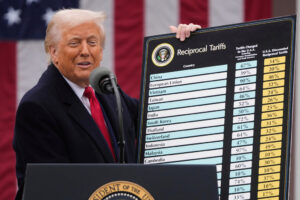Local Leaders Resist Trump Immigration Order

U.S. Immigration and Customs Enforcement (ICE) agent | US Immigration and Enforcement

President Trump issued executive orders on Wednesday to construct a border wall with Mexico and increase efforts to detain and deport undocumented immigrants.
The Trump administration hopes to use local city and state law enforcement as a dragnet to increase deportation of undocumented immigrants. The order in effect restores the Secure Communities program, a “force multiplier” program created in 2008 and expanded in 2009 during the Bush administration. The program encouraged local and state law enforcement to detain undocumented immigrants and transfer them to federal authorities for deportation. The program ended in 2014 after intense criticism from local leaders—though by that time the Obama administration had already deported record numbers of undocumented immigrants. Trump’s immigration order could return deportations to these record numbers.
The Trump administration claims that it will only target undocumented immigrants with criminal backgrounds. However, the Secure Communities program, if revived under Trump, also allows for the deportation of immigrants with non-violent criminal offenses, including civil offenses like traffic violations. The order would effectively give federal agents open discretion to deport undocumented immigrants, whether or not they committed violent offenses. This contradicts the Trump administration’s claim of only targeting violent criminals, like the “murderers and rapists” Trump repeatedly referenced during his campaign and once again this week at a press conference.
The executive order faces resistance from immigration and constitutional lawyers for violating the 4th and 5th Amendment of the US Constitution, which provides protection from unlawful searches and seizures, and guarantees due process to undocumented immigrants and US citizens alike. Under the Secure Communities program, law enforcement detained immigrants without warrant or probable cause and held detainees without trial, in direct violation of their rights. Law enforcement acted on detainment requests issued by the federal government that are not judicial warrants.
Alina Das, co-director of Immigrant Rights Clinic at New York University, said, “There sometimes seems to be a feeling that immigrants occupy a constitutional-free zone even when they are here. But it is simply not true in our case law.” Das believes local leaders need to be careful with the executive orders. She said, “Any city has to take a look at what they are doing and then analyze it– whether its violating the constitution, their own constitution, their own laws.”
Resistance to the order also falls to local city and state authorities. Leaders in local communities argue that the duty of law enforcement is to promote good community relations and protect the public, not to act as the deportation arm of the federal government. Melissa Mark-Viverto, speaker of the New York City Council, said, “Now more than ever, elected officials must stand together and denounce the president’s rhetoric and ill-conceived plans for immigration enforcement.” Mark-Viverto contends Trump’s executive order will hurt communities. She said, “If this his idea of immigration reform, he’s simply delusional. This isn’t reform. This doesn’t fix our problems. This simply creates heartache for millions of families.”
The resistance by local leaders to the Trump administration immigration order may come down to two legal questions. Will city and state governments be violating their jurisdictions and the US constitution when working with the federal government to detain undocumented immigrants? And, if local leaders resist the Trump administration to protect immigrant rights, will they be violating federal law?
Ionut Gitan is a Master of Arts degree candidate in International Politics & Business at New York University’s Graduate School of Arts & Science and Stern Business School. His professional experience includes work in fashion business and public relations between New York City and Tokyo. In his spare time, Ionut enjoys live music, design, and independent book publishing. (http://www.ionutgitan.com)




